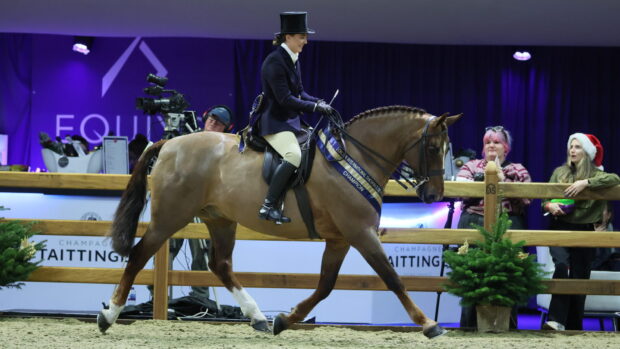Side-saddle manufacture and riding techniques are enjoying a big revival.
Side-saddle specialist Victoria Spooner says: “Technically, it’s a lot more challenging than riding astride. And besides, horses go a lot better when ridden side-saddle, as because you sit further back, you can’t interfere with the horse’s front end or the movement of his shoulders. It’s more like you’re sitting on the horse’s ‘engine’ – his back”.
Controlling a horse riding side-saddle is done in just the same way as when riding astride – through shifting your weight and balance.
“But instead of using left and right legs to communicate with the horse, your right leg is replaced by the offside cane,” Victoria explains.
“If your horseis well-schooled he’ll respond to a shift of weight in the saddle without having to use the cane very much, but side-saddle does tend to favour those horses which need little prompting to stay in canter or trot. You can’t keep kicking the horse when youride side-saddle – you’d just fall off.”
New technology
Though large-scale manufacture of side- saddles ceased around 1935, specialist saddlers continued to develop the craft until the 1950s, and today, many master saddlers arekeen to re-learn the art.
However, because saddles cost between £400 to £1,500 second-hand, and £2,500 brand new, the sport is out of reach to many.
The very latest side-saddle technology seeks to make side-saddles more affordable and relies less on tradition and more on innovation.
Designed by a former Unilever chemist, Miles Wilkins, the prototype employs the same modern composite technology and synthetic materials used in the bodywork of Lotus cars.
While traditional side-saddles from the early 1900s were made of beechwood, iron and leather, and typically weighed around 22lb (10kg), Miles managed to halve the weight and cost of his saddle using a composite of fibreglass and carbon fibre, moulded into a seat and covered in a synthetic leather fabric from Thorowgood.
Equal opportunities
Charged with the task of promoting and improving the art of side-saddle riding into the millennium, one of the main problems facing the Side-Saddle Association (SSA) today is the fact there are so few side-saddles available. Many are attic heirlooms, left to gather dust and wood worm, and when second-hand ones do become available, they’re often snapped up as antiques by collectors.
The SSAbegan some 25 years ago, when Horse&Hound magazine enjoyed a flurry of letters from unhappy readers bemoaning the loss of ladies riding side-saddle during the hunt and at shows.
The SSA now has a nation-wide membership of 1,100, with 120 qualified instructors who regularly hire out habits and saddles on short- or long-term loan to minimise expense.
As well as holding classes at shows across the country, the SSA offers an examination system with grades from 1-4, and an annual Side-Saddle Championships.



